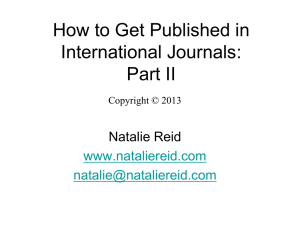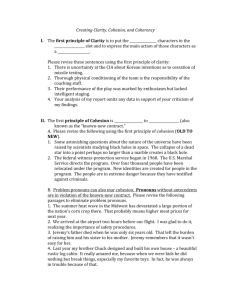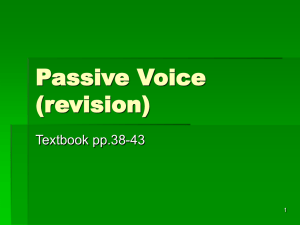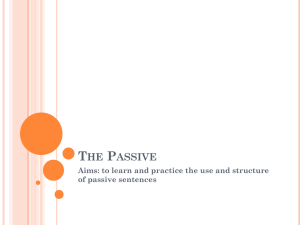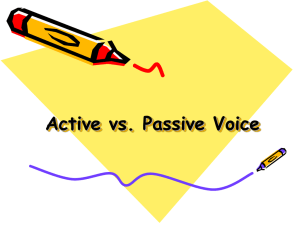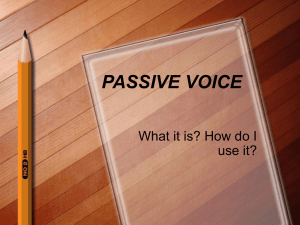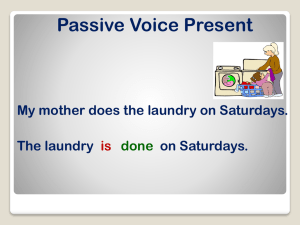Lecture Part I
advertisement
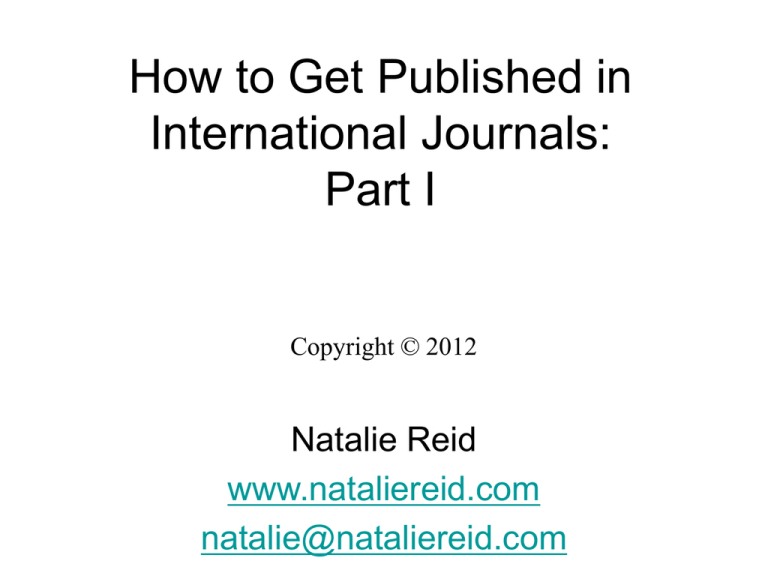
How to Get Published in International Journals: Part I Copyright © 2012 Natalie Reid www.nataliereid.com natalie@nataliereid.com Why Writing in English is Different • • • • • Theory of contrastive rhetoric The “psychology of reading” Different expectations of readers and writers Different rhetorical tradition “Writing is thought made visible” The Five Essential Strategies for Maximizing Your Publication Chances • • • • Editing for strength (less is more) Editing for clarity (clarity rules!) Organizing and arguing in Aristotelian logic Analyzing journals for elimination and submission • Revising rigorously for language, clarity, argumentation, punctuation, etc. Strategy 1: Less is More • Shorten all structure words – due to the fact that = because – in view of the above = therefore – in the course of = during • Eliminate all redundancies / condense! – – – – – various kinds of theories = various theories in the month of August = in August last but not least = last / finally / [fourth] to a large extent = largely in a professional manner = professionally Prune these sentences: “It may be that one of the problems facing research laboratories is that.... “Exams concerning the theoretical knowledge are held on a regular basis.” The Importance of Writing Clearly • “The man who can think and does not know how to express what he thinks is at the level of him who cannot think.” (Pericles) • “Nobody who thinks or writes is above grammar.” (Ayn Rand) Strategy 2: Editing for Clarity • Avoiding Ambiguity: Using pronouns correctly • Writing in the Active (not passive) Voice • Placing Words Where They Belong: Using modifiers correctly • Using Parallel Structure • Punctuating for Clarity in UK or US (or other) English Using pronouns correctly • Do not use “this” (or “these”) by itself. Add the appropriate noun: “This discrepancy led to....” “These findings are inconclusive....” • Use personal pronouns only when there is only one word in the sentence they can refer to. For example, do not use “it” or “they” if there are two or more words in the sentence to which the word could refer. Instead, repeat the noun. Using “which” & “that” • These words must refer only to the word in front of them—not to anything else. Edit this sentence: “This lack of data standardization both within and between [institutions] is often identified as a barrier to both the take-up and the efficient use of [X], which causes the following problems:” Active v. Passive Voice I like ice cream. (S + V + O) [“Active” because the S is doing the action] Ice cream is liked by me. O masquerading as subject + passive V [is liked] + S forced into the OP position [as the object of the word “by”] [“Passive” because the S is passive, i.e., is having something done to it] Active v. Passive Voice, cont. “People often use the passive voice because it’s indirect, polite, unaggressive, and admirably suited to making thoughts seem as if nobody had personally thought them and deeds seem as if nobody had done them, so that nobody need take responsibility. Thus the passive is beloved of bureaucrats and timid academics....” (Ursula K. LeGuin) “Never use the passive where you can use the active.” (George Orwell) Active v. Passive Active: The participants asked excellent questions. Passive: Excellent questions were asked by the participants. Make the first sentence active. Then fix the pronoun problem in the second one. “In the following four sections an [X] example of a [Y] case study is presented. It shows how to form the [Z].” Modifier Problems • The doctor told her patient frequently to exercise. Modifier Problems • Found: a purple man’s coat Dangling Modifier Problems • To validate the results, a second experiment was conducted. • Based on the results, we conclude that X factors do not cause Y conditions. Dangling Modifiers Wrong: Based on our review of the findings, we agree that the researcher should reconsider his conclusions. Right: Based on our review of the findings, our position/our decision is that the researcher should.... After reviewing the findings, we agree that the researcher should.... Given the findings, we agree that the researcher should.... Using Parallel Structure • Parallel information must appear in parallel style • A sentence starting with “also” is usually a firstdraft sentence giving information that belonged in the sentence that preceded it. • Sentences using co-relative conjunctions (eitheror, neither-nor, both-and, not only-but also) must present material in parallel style. Parallel Structure Poor: The organization of the group provided an effective framework for the sharing of knowledge and skills development. Better: The organization of the group provided an effective framework for skills development and the sharing of knowledge. Punctuation • Punctuation is a code of meaning signifiers critical to clarity in English. • The absence or presence of a comma in a particular place can not only change but actually reverse the meaning of a sentence. • UK and U.S. English use very different punctuation. • Apply every rule in any style manual that your journal of choice wants you to use. • If the journal specifies none, use one of the best. Strategy 3: Organizing and Arguing in Aristotelian logic • • • • Arguing according to the Greeks Ethos, pathos, and logos Five-paragraph essay model John Swales’ CARS model: – Establish the territory – Establish the niche – Occupy the niche (i.e., purpose statement) What Goes Where in a Paper • Introduction (depending on journal) – Necessary background / territory & niche – Purpose statement – Brief description of data set – Scope – (in certain fields) Results & conclusions What Goes Where in a Paper • Body (everything between the introduction and the conclusions necessary theory or background or literature review methodology data results (plus robustness checks, etc.) What Goes Where in a Paper • Conclusion – Nothing new goes in a conclusion! It must derive solely and logically from the information and organization contained in the Body. – If the journal has a Discussion section.... What Goes Where in a Paper • Discussion / Recommendations for Future Research, etc. – These sections must naturally come out of the Conclusions; that is, they must remain within the framework of all previous discussions (e.g., our study of X was limited to Country Z; future research should include additional environmental factors, such as....) The Abstract • Should be presented first but written last • Should never exceed journal’s word limit. [Usually includes territory (if nec.), niche, purpose statement, results, conclusions, future research (if nec.)] • Should omit details • Must follow style of most common abstract pattern in journal Strategy 4: Journal Analysis • THURSDAY’S LECTURE: • Elimination analysis: how to eliminate all journals that are inappropriate to your paper for one reason or another • Submission analysis: linguistic and organizational analysis of your journal of choice Strategy 5: Revision & (Re)Submission • “Read and revise, reread and revise, keep reading and revising until your text seems adequate to your thought.” (Jacques Barzun) • “A good style must, first of all, be clear.” (Aristotle) • “Rewriting is the essence of writing well: it’s where the game is won or lost.” (William Zinsser) Strategy 5: Revision & (Re)Submission “Over 200 years ago Benjamin Franklin wrote: ‘Either write something worth reading or do something worth writing.’ Scholars, engineers, and researchers need to do both. The quality of the writing must be as good as its contents, and you must be as good a writer as you are a thinker, theorist, or researcher. If the writing isn’t good, your publication chances are very poor.” Preliminary Revision Checklist • Is my language correct? – Did I use “claim” when I meant “state”? – Do I mean “comprise” or “constitute”? – Have I eliminated “in fact,” “so-called,” “the fact that,” and other words that constitute poor style? • Is everything in the appropriate section? • Does my argument support my conclusion? • Am I bored or confused reading a certain passage (because if I am, the reader certainly will be)? Preliminary Checklist, cont. • Does my argument proceed logically? Is it airtight? • Have I named and countered all possible objections? • Have I considered and minimized all possible disadvantages? • Have I anticipated and answered all my reader’s likely questions? Preliminary Checklist, cont. • Have I defined all my terms—and in the right place (i.e., at first mention)? • Have I used any language with which my reader may not be familiar? • Have I proofread every word and punctuation mark? • Am I consistent in vocabulary, spelling, punctuation, and grammar for UK or U.S. (or other) English? • Am I using the right “confidence tone”? Most Important • Does everything (e.g., # of tables, length of sections) match the style of the journal? • Have I followed the journal’s style/author guidelines to the letter (e.g., APA Style Manual, Chicago Style Manual)? • Has a properly skilled native speaker of English read and edited the final draft? [Not every native English-speaking scholar is a good academic stylist, nor is a neighbor’s American or British spouse with no training in editing or academic writing a wise choice.] Resubmission Letters • Never assume that the editor remembers the content of your paper or anything that he or she wrote to you. • Never make the editor have to go back and forth between two documents. • Therefore, always cut-and-paste the reviewers’ comments, with your revisions and comments following in a different font or format. Resubmission letters, cont. • Use language such as – I applied this helpful suggestion to.... – As referee 2 has suggested, I have changed.... – This revision makes much more clear how we draw our conclusions. – Thanks to this comment, the revised article now more clearly focuses on.... – Following reviewer 1’s suggestion, we have considerably reduced the extended example. We now link the case directly to both the theoretical framework and the practical consequences of X for [specific group]. To Recap: Some Overall Guidelines • • • • • • • • • Be as concise as possible without sacrificing meaning. Keep your sentences and paragraphs reasonably short. Define all your terms the first time you mention them. Always be clear—never allow your reader to become confused (not even for one sentence). Write in the active voice. Frame (contextualize) everything. Frame your paper as important to the field. Always let the reader know what you are doing—and why. Create as airtight a proof as possible. Always write for a specific journal. Revise and revise. Then have a skilled native speaker of English read and comment on the final draft.
